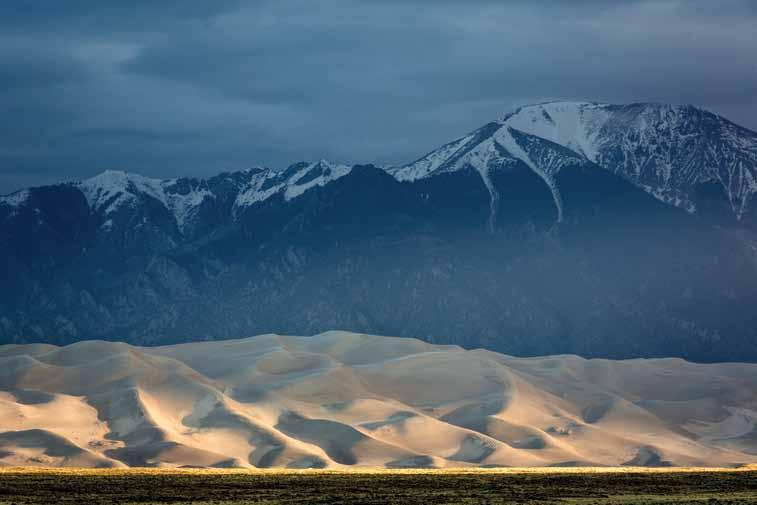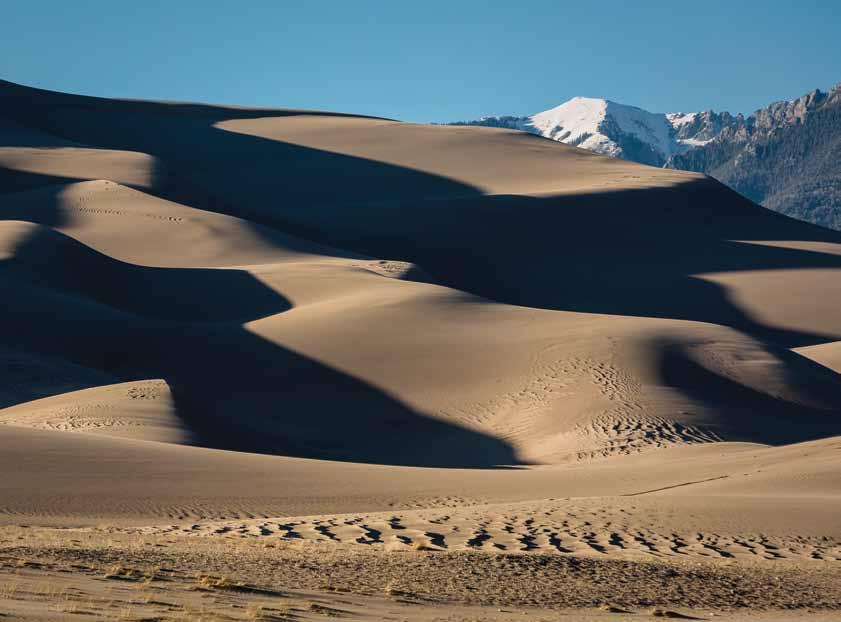
10 minute read
outside the Park Boundary
How Local Communities are Conserving Private Lands through Partnerships with Land Trusts
Great Sand Dunes Wilderness. Photo by Dan Orcutt
By Bryan Martin, External Relations Officer, Land Trust Alliance
All across America, people are working together to conserve fields, farms, forests, parks, and trails close to home. They bring energy, creativity, and local knowledge of their community. They believe that America’s special places should be protected—unchanged into the future—and they seized upon an extraordinary idea. They formed land trusts.
Land trusts harness three fundamental American values—private initiative, community cooperation, and a deep connection to the land. They are as diverse as the people and communities they serve, but share a common mission: to protect the places that people value most. America’s 1,700 land trusts have now conserved 50 million acres, boast over 12,000 staff, and have garnered over five million supporters. Land trusts conserve more than two million acres every year.
This is important because every day we lose 5,000 acres to development. Orchards, farms, meadows, climbing areas, and vast natural areas are being converted to shopping malls, office parks, condos, and roads. The United States population is projected to grow by 100 million and the amount of land covered by development will triple by the year 2050. More than eight percent of our population will live in metropolitan areas where open space will be increasingly precious.
In light of this development pressure, Americans yearn for clean water and food that is safe, fresh, and local. We want time in nature to improve our fitness and prevent illness. We want our children to thrive in school and grow up in a safe and nurtur-
Looking towards the Sangre de Cristo Mountains. Photo by Dan Orcutt
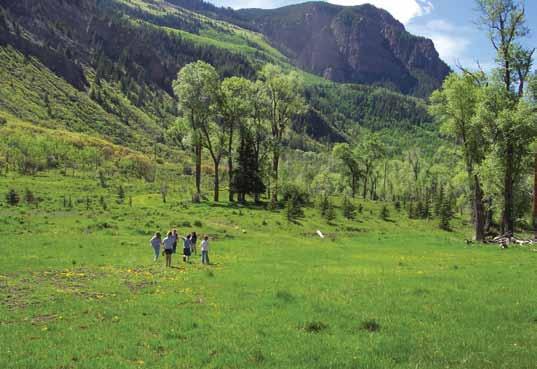
A field trip with the Roaring Fork Conservancy. Photo courtesy of Land Trust Alliance
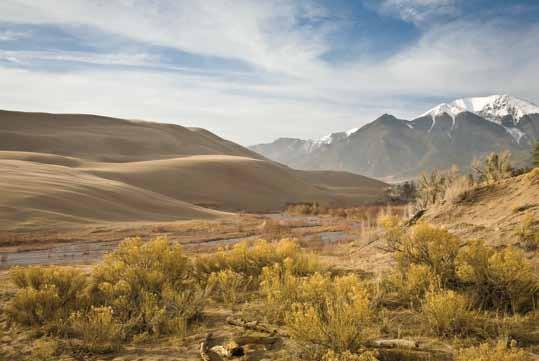
ing community. And we want to live in a place with a robust and sustainable economy with lots of job prospects. Land trusts are increasingly finding local solutions to these complex national problems, community by community. By conserving land, land trusts protect clean drinking water and the farms that provide healthy food. They provide access to nearby parks and trails to enrich lives and reduce health care costs. And they generate jobs by revitalizing communities, making it attractive for businesses to relocate, start up, and hire— to say nothing of the protected working forests and ranches that generate rural jobs as well as the revenues from outdoor recreation and tourism stemming from visiting protected lands.
While congressionally designated “Wilderness” continues to slow and opposition mounts to federal designations of protected land, private land conservation has accelerated and many people believe that, going forward, land conservation will increasingly depend on land trusts and voluntary partnerships with private landowners.
A confidence in this trend and the popularity of local land conservation through land trusts—and other local stewardship organizations—has enabled many state and federal policy victories in recent years. Since 2000, the Trust for Public Land has participated in over 300 winning local ballot measures to create new public funds for parks and land conservation—an 81 percent success rate—creating $35 billion in voter-approved funding for parks and open space. More recently, the Land Trust Alliance succeeded in leading a broad national coalition in the congressional approval of over $1.3 billion within the Farm Bill for the purchase of conservation easements on farm land. On the horizon, with leadership again coming from the Land Trust Alliance, Congress is poised to pass a permanent extension of the conservation easement tax incentive—a tax incentive to landowners who donate conservation easements on their land.
How Land Trusts Work you may be asking “What is a conservation easement?” Land trusts primarily protect land in two ways—by purchasing the land outright or by receiving a donation of the development rights to the land. The latter is known as a conservation easement and as land prices continue to climb, conservation easements have become the most important tool for land trusts when protecting land in a local community.
A conservation easement is a written agreement between a landowner and the “holder” (often times the land trust) of the conservation easement under which a landowner voluntarily restricts certain uses of the property to protect its natural, productive, or cultural features. The holder of the conservation easement must be a governmental entity or a qualified conservation organization. With a conservation easement, the landowner retains legal title to the property and determines the types of land uses to continue and those to restrict. As part of the arrangement, the landowner grants the holder of the conservation easement the right to periodically assess the condition of the property to ensure that it is maintained according to the terms of the legal agreement.
Many rights come with owning property, including the right to manage resources, change use, subdivide, or develop. With a conservation easement, a landowner limits one or more of these rights. For example,
a landowner donating a conservation easement could choose to limit the right to develop a property, but keep the rights to build a house, raise cattle, and grow crops. The landowner may continue his or her current use of the property, provided the resources the conservation easement is intended to protect are sustained. Because every landowner and every property is unique, a conservation easement agreement can be designed to meet specific, individual, and community needs.
At Work in the West
In the West and in Colorado in particular, there is increasing synergy between public land (local, state, and federal) and protected private land. And the results have created immense benefits for wildlife, endangered species, recreationists, and local economies. Perhaps the most prominent example of where a land trust worked with state and federal land managers to protect land, water, and bolster a local economy was when The Nature Conservancy purchased the Baca Ranch and set in motion the deal that created the Great Sand Dunes National Park as we know it today. In September 2004—four years after negotiations began—the $35 million deal was completed, making it the largest single transaction to date for The Nature Conservancy in Colorado. Great Sand Dunes National Monument nearly quadrupled in size and was upgraded to a national park; the Rio Grande National Forest claimed the alpine portion of Baca Ranch, including 14,165-foot kit Carson Peak; and 54,000 acres of grassland and wetland habitat became the Baca National Wildlife Refuge. And even more land has been protected since then. Last year, the 170,000-acre Sangre de Cristo Conservation Area was created after landowner Louis Bacon placed conservation easements on his Trinchera and Blanca ranches with Colorado Open Lands (a statewide land trust based in Lakewood), extending protection nearly all the way to New Mexico (including portions of Blanca Peak, Mt. Lindsey, and Trinchera Peak).
The creation of the national park, and subsequent follow-up protections, has been a boon for the local economy in the San Luis Valley. But this is not an anomaly. All across the West, our popular national parks, monuments, wilderness areas, and other public lands have provided a competitive advantage for western state economies. A recent study by Headwaters Economics has documented that western states have outperformed the rest of the United States economy in key measures of growth—employment, population, and personal income, in part because of the proximity of these states to public land.
Entrepreneurs and talented workers are choosing to work where they can enjoy outdoor recreation and natural landscapes. Increasingly, chambers of commerce and economic development associations in every western state are using the region’s national parks, monuments, wilderness areas, and other public lands as a tool to lure companies to relocate. High-wage services industries also are using the West’s national parks, monuments, wilderness areas, and other public lands as a tool to recruit and retain innovative, high-performing talent.
Land trusts are working across the country on public access projects, consolidating wilderness areas, and providing buffers to existing public resources. In February, the Wilderness Land Trust, based in Carbondale, Colorado, purchased the Painter Mine on the banks of the Salmon River in Idaho with plans to restore the property over two years and then transfer it to become part of the Frank Church River of No Return Wilderness.
The Access Fund, which is earning its national accreditation from the Land Trust Accreditation Commission, has been working on opening legal access to Gold Butte, a pinnacle of Entrada sandstone just outside of Aspen, Colorado, which was once a popular spot with local climbers in the 1970s but was closed to public access in 1983 by the private landowners. The Access Fund has been working with local climbers and Pitkin County Open Space and Trails to acquire the property, advise on risk management, and develop a climbing management plan for the area. It was recently announced that the county has successfully completed the purchase, and Gold Butte is now open to the climbing public.
Evergreen-based Mountain Area Land Trust has protected over 20,000 acres in the mountains from Boulder County to Park County, buffering many of the forests, parks, and open space areas that dot the high country just west of the Denver metro area. These projects have contributed greatly to the scenic views and natural experiences enjoyed in many of these easily accessed parks and trails.
Land trusts and public agencies need each other. Each agency may have different goals in mind but they all greatly value their partnerships with land trusts. Land trusts have the ability to work quickly to acquire a piece of land, whereas a federal or state agency has to wait for the appropriation to be budgeted. Also, land trusts are smaller and more nimble organizations than the larger federal and state institutions so they can take advantage of opportunities faster. A great example of this was when the Jackson Hole Land Trust purchased a tiny parcel of land in the middle of Grand Teton National Park that could have been easily developed into a hotel. The park was very grateful for the quick action the land trust took to purchase the property and hold it until the park could get the funds appropriated to take it off of the land trust’s hands.
Another way land trusts and agencies partner is through lobbying. The agencies can’t lobby Congress, but land trusts can. And land trusts have become increasingly skilled at impressing upon Congress the need to appropriate funding for the purchase of specific tracts of land. Whether it is flexibility, education, or community support, what land trusts bring to partnerships with land management agencies is highly valued in their shared goal of land conservation.
What’s Ahead
The land trust movement in the United States has never been stronger, and from that success comes new responsibilities. Land trusts share a destiny with the communities in which they work and land trusts are working hard to understand and respond to the needs and aspirations of those communities. If you hold 20% of a state, like land trusts do in Maine, it’s no longer feasible to assume that issues like transportation, poverty, food security, or how people heat their homes is not your concern. Moreover, the United States of America that is emerging right now is very different from the United States of the 1980s, when the majority of land trusts were formed. How will land trusts choose to relate with their changing communities? Will land trusts innovate over the next 25 years, as they have during the past 25 years?
Connecting communities to nature through recreation is one way land trusts are finding common ground with communities. Land trusts’ recreational properties are improving peoples’ health and
well-being. They are helping communities own significant land resources for parks, playgrounds, and urban farms. All of this helps communities to be more resilient. And it helps land trusts to become more resilient, innovative, and successful. What land trusts are calling “community conservation” is already building a stronger constituency for conservation far beyond the usual suspects.
Today, our communities need to be more closely connected to the land and our practices of conservation need to be more closely aligned to the needs of people. By focusing conservation on sustaining livelihoods, on increasing public health, on strengthening food systems, and on how we educate our children, conservation becomes culture and culture becomes more rooted in the land. The outcomes of this work are more resilient, healthier communities more closely connected to the land, and a conservation movement that transcends its privileged roots to be in service to more Americans. Land trusts are increasingly finding themselves, and pushing themselves to be, the conduits of these connections. △
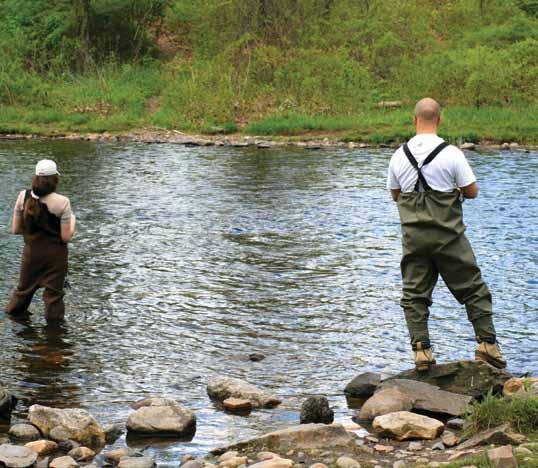
Colorado Parks and Wildlife provides hunting and fishing access through its Habitat Protection Program and grants funding to land trusts. Photo courtesy of Land Trust Alliance
The Baca Ranch purchase created the Great Sand Dunes National Park as we know it today. Photo by Dan Orcutt
